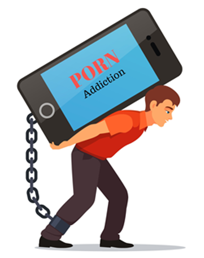Part-1 of: America’s “other” Epidemic
Much has been written about America’s opioid epidemic – from the runaway greed of Purdue Pharma and the Sackler family misrepresenting Oxycontin’s highly-addictive potential[i], to the mounting annual death toll from drug overdoses directly attributed to opioid dependency[ii], to the move to synthetics and other opioid-based drugs (e.g., heroin, fentanyl) as prescriptions became more tightly controlled. A defining feature in all of this is that addiction can happen to anyone, anywhere, regardless of one’s socio-economic line, education, profession, race, age, or gender. No longer relegated to “low class druggies, bums and others with low moral character or lack of willpower” (a stereotypical stigmatization levied on addicts), the opioid epidemic has shown that anyone can become dependent upon and addicted to drugs. The Center for Disease Control (CDC) maintains an informative portal[iii] covering all aspects of opioids, including basic information, statistics, and prevention guidance. The CDC also tracks and reports on annual drug overdose deaths[iv], showing the impact opioids are having.
As horrific as this is (with nearly a million overdose deaths since 1999[v]), there’s another even more insidious cancer eating away at the flesh of our society – pornography.
A Christian worldview makes identifying pornography as immoral simple – lust, fornication and adultery are covered in numerous books and passages in the bible. For the secularist, or one with a naturalistic worldview, qualifying pornography as bad, unhealthy, perverse, immoral, etc. can be more difficult given there’s no objective morality – all opinions are personally subjective. Debating objective vs. subjective morality is not the point of this article; rather, I’ll look at pornography (hereafter referred to as porn) through the lens of how it’s causing harm in three (3) areas:
- destroying relationships by desensitizing us to true sexual and relational intimacy
- dehumanizing our view of others by reducing us to nothing more than objects of lust and personal sexual gratification, and
- destroying the innocence of children by exposing them to every conceivable form of sexual practice, including rape, incest, BDSM, child pornography, bestiality, etc.
Of the three harms listed above, the concerns about exposing young children to all forms of paraphilia are the gravest; brain and behavioral researchers are just beginning to understand the short- and long-term harms of exposing pre-teens, teens and young adults to pornography, some before they’ve gone on their first date.
Part-1 of the article “America’s ‘other’ Epidemic” looks at the biological and behavioral aspects of porn use through the lens of addiction and how a person becomes enslaved to the process of acting out, eventually becoming powerless to stop or moderate the destructive behavior despite severe negative consequences. Understanding the mechanisms of addiction helps explain how desensitization destroys relationships, how objectification dehumanizes the vulnerable, and the exigent threat to an entire generation growing up with unfettered access to the most extreme sex acts imaginable. You don’t have to become addicted to be harmed; not all porn use results in addiction, but any porn use can result in personal and relational harms which can be tricky to reverse, and almost always results in regret.
What Is Porn?
Ask 10 random people what they believe to be pornographic and you’ll get 10 different answers, all variations on a common theme. Ask the question across generational lines and the answers will vary from “dirty pictures I found in my dad’s Playboy stash (a Boomer)” to “I found free pictures of naked people on the Internet while working or doing homework (a Gen-X)”, to “I can access unlimited free videos of any form of sexual content you can imagine from my smartphone or tablet (Gen Y)”, and finally “my friends and I routinely exchange (sext) naked pictures of ourselves and share webcam videos of us engaging in all sorts of sexual experimentation (Gen-Z)”.
The philosophy database (Plato) at Stanford University offers the very simple definition[vi] “any material (either pictures or words) that is sexually explicit”, then refines that to exclude content not primarily intended to produce sexual arousal (i.e., an anatomy textbook graphically depicting genitalia). The revised definition is “sexually explicit material (written or pictorial) that is primarily designed to produce sexual arousal in viewers”. This is an adequate definition for our purposes, with the caveat that anything explicit designed to produce sexual arousal can be considered porn except when exchanged within the confines of marriage.
Is It Addiction?
There’s great controversy within the medical communities as to whether sex addiction exists and, if it does, how it should be classified, diagnosed (specific qualifying criteria) and treated. The American Psychiatric Association (APA), responsible for updating the Diagnostic and Statistical Manual of Mental Disorders (DSM) has vacillated over the years; i.e., Hypersexuality Disorder included in the DSM-IV was removed entirely from the DSM-V (2013) citing a lack of empirical data with conclusive findings. The exclusion was baffling to the growing number of professional clinicians and practitioners who presented an ever-expanding body of evidence, compiled over decades, demonstrating sex addiction clearly exists in form and function alongside other substance use and behavioral disorders.
While qualifying criteria exists (examples below) to identify sex as an addiction, and effective treatments continue to mature, the exclusion of any form of diagnosis in the DSM makes legitimizing diagnosis and treatment difficult, at least from the evidence-based medical and insurance standpoints necessary for treatment.
Outside the U.S, the World Health Organization (WHO) in 2018 included Compulsive Sexual Behavior Disorder (CSBD) in the International Classification of Diseases 11th Revision (ICD-11) with the following summary characteristics[vii]:
characterized by a persistent pattern of failure to control intense, repetitive sexual impulses or urges, resulting in repetitive sexual behavior over an extended period (e.g., six months or more) that causes marked distress or impairment in personal, family, social, educational, occupational or other important areas of functioning.
Regardless the label – sex addict, porn addict, Hypersexuality Disorder, Compulsive Sexual Behavior Disorder – knowing the qualifying characteristics of sex addiction will go a long way in realizing help is needed. The Sex Addicts Anonymous (SAA) website lists six characteristics of someone struggling in this area. They are:
- Powerlessness over addictive sexual behavior.
- Resulting unmanageability of his/her life.
- Feelings of shame, pain, and self-loathing.
- Failed promises and attempts to stop acting out.
- Preoccupation with sex leading to ritual (this is important – more below).
- Progressive worsening of negative consequences.
If these characteristics resonate, you can go one step farther and take the “am I a sex addict” self-assessment on the SAA website. Sex Addicts Anonymous addresses all forms of sex addiction (e.g., massage parlors, escorts, saunas & rest stops, pornography, serial affairs, “seeking” behavior, voyeurism, exhibitionism, paraphilia, frotteurism, etc.). If the struggle is just (or primarily) pornography, Porn Addicts Anonymous also lists qualifying criteria as well as an “am I a porn addict” self-assessment.
Again, the specific label or diagnosis is less important than identifying and addressing the destructive behaviors resulting in ruined lives and relationships, objectification of others for selfish sexual gratification, and the loss of youthful innocence. Even more troubling but beyond the scope of this paper, pornography has tentacles in sexual exploitation, aggression and abuse, child pornography and child sexual exploitation, and human (sex) trafficking. The organization Human Trafficking Search exposes the connection between pornography and sex trafficking in the article[viii] “The Connection Between Sex Trafficking and Pornography”.
Desensitization Destroys Intimacy (and Relationships)
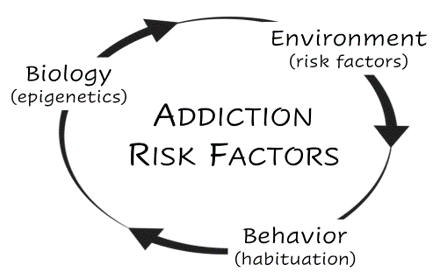
In June of 2021 I wrote an article titled “The Porn Addicted Brain[ix]” where I made the case for how sex addiction, like all other addictions, is a brain disease. Understanding desensitization begins with an understanding of the addictive process. Addiction is a complex, multifactorial disorder involving genetics, environment, triggers and conditioning, cyclical behaviors, and changes in the structure and function of the brain. In short, addiction arises as a result of a person’s biology (genetics), the environment in which they’ve grown up, and the extent to which they’ve relied on the substance or behavior to seek pleasure or escape pain.
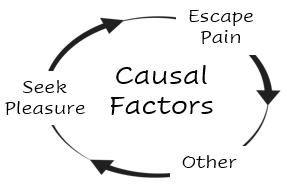
Addiction is a Trap, not a Choice: at a certain point an addict caught in the cycle of addiction loses complete control of their ability to think, reason or act in a rational way – they become powerless to stop the cycle of acting out, no longer able to use their mental faculties to make sane and responsible choices. For the sex addict, once Triggered (the first stage in a six-stage cycle) and without resources to interrupt the process, they quickly fall into Fantasy (the second stage), then into the third stage which is Ritualization. For the addict, the ritual they’ve developed as part of their acting out process is the real goal; addicts refer to this stage as “the bubble” or “sex trance” because they become completely consumed in the process, losing all touch with reality – their entire world collapses down to this one singular imperative. Addicts try to extend the ritualization stage as long as possible – this is where intensity, excitement and arousal are at their peak. This state of heightened senses is where the neurobiological aspect of addiction manifests – I’ll expand on that below in the section The Porn Addicted Brain.
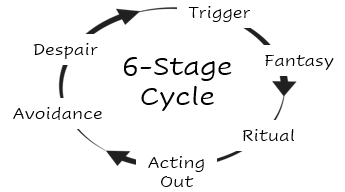
While people might think completing the next stage of Acting Out (the sex act) and achieving orgasm is the ultimate goal, for the addict the opposite is true – the sex act itself is often disappointing and achieving orgasm pops the bubble and ends the high, throwing the addict into the next two phases, which are Avoidance and Despair. Avoidance is the mental and emotional process of trying to distance oneself from what they’ve just done – act out, again; there are usually countless prior unsuccessful attempts to stop. This leads to Despair, which manifests as shame, guilt, remorse, desperation, depression and self-loathing. Depression, sometimes with suicidal ideation, is a common co-occurring disorder for the sex addict caught in this repeating cycle. Biology and environment operate together to drive behavior and, once habituated, these behaviors are cemented in place by our brain’s neurobiology.
Let’s look briefly at how addiction changes the brain in structure and function, such that no amount of willpower, coercion or negative consequences can interrupt the cycle.
NOTE: I’ve touched only briefly on the six-stage sex addiction cycle; for a more detailed explanation see the “The Cycle of Sex Addiction[x]” by Robert Weiss PhD, LCSW, Chief Clinical Officer of Seeking Integrity LLC and author of the excellent book Sex Addiction 101[xi].
The Porn Addicted Brain
I’ve summarized the cycle of addiction as it relates to pornography because it’s important to recognize and understand the cyclical process sex addicts follow once they’ve crossed the line from user/abuser to addict. This acting out cycle is similar for drug addicts and alcoholics, and also for people struggling with other process addictions (e.g., gaming, shopping, social media, food, exercise, gambling, etc.). But HOW does the addict get trapped? What happens to lock them into this cycle of self-destructive insanity? Why can’t they just stop?
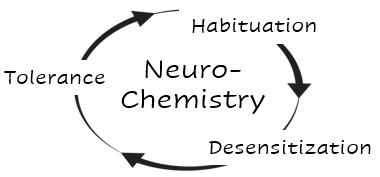
Neurochemically what happens in the brain of a porn user is no different from what happens in the brains of drug addicts, alcoholics and people with process additions – over time the brain is altered in structure and function when subjected to repeated use of the substance or process. This is normal and expected – practice makes perfect after all – if a person practices the piano 2-3 hours per day for 10 years, you expect that person to have some level of mastery with the piano. So it is with substances and behaviors. Neurologists call this neuroplasticity – the brain’s ability to modify, change, and adapt both structure and function throughout life in response to experience.
Said a different way, neurons that fire together wire together, and neural pathways are created and strengthened in response to repeated use. That’s great if what’s being repeated is a positive, affirming and useful skill, but what if it’s sitting for hours in front of a screen watching porn? Over time neural pathways are structurally changed in response to the repetitive “practice” of using. In addition to structural changes (as if that weren’t bad enough), the brain’s reward system (the Mesolimbic System) is functionally altered causing severe changes in neurotransmission, some that can take years to reverse[xii].
The Reward System functions to register positive experiences necessary for thriving and survival. When this system fires in response to a positive, pleasurable or rewarding event, it registers this as something necessary which should be repeated, then checks in with other systems (i.e., the Mesocortical System) responsible for memory, attention, learning, and emotional regulation. Together, these systems ensure positive, pleasurable experiences are remembered and neurochemically strengthened so as to guarantee they’re repeated.
Used properly, the reward system (pathway) ensures positive behaviors are registered, remembered and tied to related emotions; we welcome these feelings of pleasure and happiness and are highly motivated to repeat them. BUT, what if the system is triggered artificially either by a substance (e.g., cocaine, heroin, etc.) or by a behavior, such as gambling, internet gaming, or viewing pornography? It’s well known that substances act on the brain by stimulating the release of dopamine (and other neurotransmitters), and it’s now understood that process addictions operate in much the same way. Here’s the problem, and this is why it can be devastatingly hard for the addict to stop and stay stopped; artificially triggering the reward pathway causes it to function in an irregular way, releasing far more dopamine than normal, and sustaining the abnormal activation for extended periods of time.
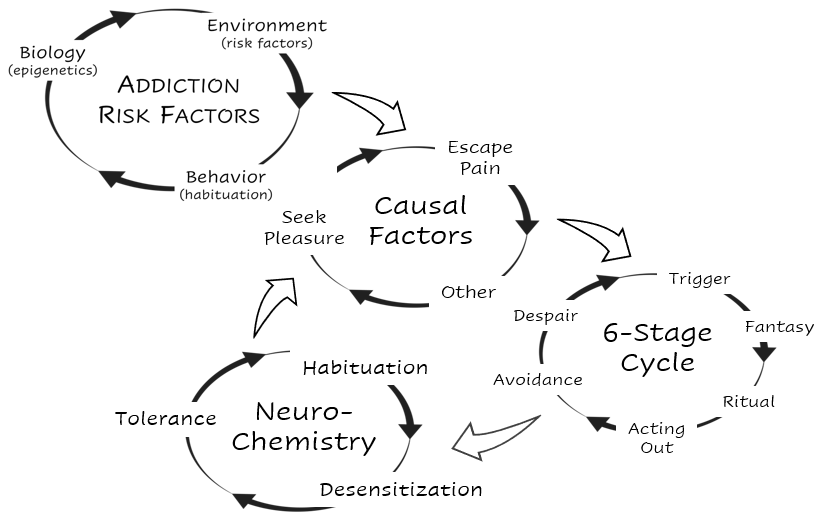
It’s not unusual for porn addicts to spend hours each day scrolling many hundreds of images or watching dozens of videos. I call this “the porn-soaked brain”; another way to say this is “the dopamine-soaked brain” because the abnormal activation and increased release of dopamine for extended periods delivers sustained euphoric effects. Remember, this activity is usually tied to seeking pleasure or escaping pain (there are other motivations), and the process of watching porn for extended periods is typical of ritualization, where the experience of excitement and arousal are at their peak. Completing the “session” with masturbation leading to orgasm breaks the trance and ends the high.
Abusing the reward system in this manner has a number of unfortunate side effects: first, addictive practices are self-perpetuating – the more you do, the more you’ll want or need to do (neuroplastic habituation). Addictions (or ‘use disorders’ as is becoming vogue) almost always escalate with increasingly destructive behaviors and worsening consequences. Second, with escalation comes tolerance – the more you do the more you’ll need to do to achieve the same high. This is due in part to the brain trying to regulate the abnormal flood of dopamine by reducing the number of dopamine receptors on the post-synaptic neuron; this causes a desensitization[xiii], requiring more of the substance or behavior to achieve the same effect. It’s a vicious trap – get triggered (i.e., escape pain), fall back into ritual despite vowing not to, maintain the euphoric trance as long as possible, act out, realize what you’ve done and respond with feelings of shame and despair, then start the process all over again. This is neuroplasticity at its worst.
It really is an unfortunate trap – fortified behaviors derived from habituated experiences in this part of the brain can be very difficult to change. Further, this reward system does its work long before the thinking part of the brain (the decision-making executive function found in the pre-frontal cortex) is engaged to logically or rationally test whether a behavior is good or bad, right or wrong, or helpful or hurtful given the known, anticipated or memory of prior consequences. Addicts, and all the people who love them, are beyond exasperated when a relapse occurs, but perhaps we should be more surprised when a person with a habituated use disorder doesn’t slip back into their well-practiced and neurologically-conditioned habit.
Segue to Part-2 of “America’s ‘other’ Epidemic”
In Part-1 I established what porn is, touched on the medical community’s current position on whether it’s an addiction, use disorder, or something else, and elucidated the fundamentals of the addiction process, including the attendant neurobiological changes. In Part-2 I’ll detail the unfortunate impact porn is having on individuals, couples in relationship, and young people just starting to become aware of their own sexuality (and how they fit into a society of other sexual human beings). I’ll also cover how porn causes dehumanization by turning others into objects of selfish sexual gratification, and finally, I’ll present a number of solutions that exist for any kind of identified porn-use disorder or addiction.
Today the problem of pervasive pornography feels like a runaway train, and it can be disheartening to look at the statistics, especially for how pre-teens and teens are impacted. But there is hope and there is help; once we understand the true nature of the problem, we can support each other in finding solutions that reverse the damage and restore broken lives.
ENDNOTES & CITATIONS
[i] National Opioids Settlement. https://nationalopioidsettlement.com/
[ii] Ahmad FB, Rossen LM, Sutton P. 2022. Provisional drug overdose death counts. National Center for Health Statistics. https://www.cdc.gov/nchs/nvss/vsrr/drug-overdose-data.htm
[iii] Centers for Disease Control & Prevention – Opioids. https://www.cdc.gov/opioids/index.html
[iv] Centers for Disease Control & Prevention – Drug Overdose Deaths. https://www.cdc.gov/drugoverdose/deaths/index.html
[v] Mann, Brian. More than a million Americans have died from overdoses during the opioid epidemic. December 30, 2021. https://www.npr.org/2021/12/30/1069062738/more-than-a-million-americans-have-died-from-overdoses-during-the-opioid-epidemi
[vi] West, Caroline, “Pornography and Censorship”, The Stanford Encyclopedia of Philosophy (Fall 2021 Edition), Edward N. Zalta (ed.), https://plato.stanford.edu/archives/fall2021/entries/pornography-censorship
[vii] Compulsive sexual behavior disorder in the ICD‐11. Published online 2018 Jan 19. doi: 10.1002/wps.20499. https://www.ncbi.nlm.nih.gov/pmc/articles/PMC5775124/
[viii] Human Trafficking Search. April 2014. The Connection Between Sex Trafficking and Pornography. https://humantraffickingsearch.org/the-connection-between-sex-trafficking-and-pornography/#:~:text=Pornography%20is%20also%20used%20by,forced%20performance%20in%20the%20industry
[ix] Barnard, Stephen. June 2021. The Porn Addicted Brain. https://narrativescoaching.com/the-sex-addicted-brain/
[x] Weiss, Robert. InTheRooms.com. The Cycle of Sex Addiction. https://www.intherooms.com/home/iloverecovery/all/the-cycle-of-sex-addiction-robert-weiss-msw/
[xi] Weiss, Robert, PhD, LCSW. October 2015. Sex Addiction 101: A Basic Guide to Healing from Sex, Porn, and Love Addiction. https://www.amazon.com/Sex-Addiction-101-Basic-Healing/dp/0757318436
[xii] Volkow, N. D., Fowler, J. S., & Wang, G. J. (2003). The addicted human brain: insights from imaging studies. The Journal of clinical investigation, 111(10), 1444–1451. https://doi.org/10.1172/JCI18533
[xiii] NIDA. 2022, March 22. Drugs and the Brain. Retrieved from https://nida.nih.gov/publications/drugs-brains-behavior-science-addiction/drugs-brain on 2022, March 24

